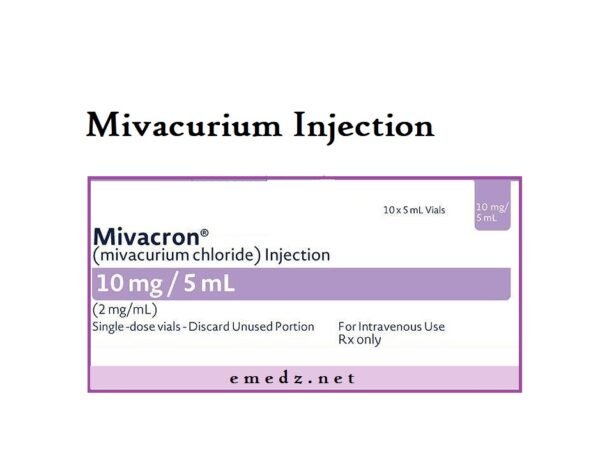A neuromuscular blocking medication called mivacurium (Mivacron) is given to patients who are undergoing surgery or receiving mechanical ventilation.
Mivacurium (Mivacron) Uses:
-
Neuromuscular inhibition for surgery, mechanical ventilation, or endotracheal intubation:
- During surgery or when ICU patients aren't sedated properly for mechanical breathing, this is recommended as an addition to general anesthesia.
- It helps with putting a tube in the windpipe and relaxing muscles.
Note:
- Neuromuscular blockade only relaxes skeletal muscles and doesn't offer pain relief, sedation, or memory loss effects.
- To achieve a deep state of sedation, it's important to administer pain relievers and sedatives before and during the use of neuromuscular blockade.
-
Off Label Use of Mivacurium in Adults:
-
Acute Respiratory Distress Syndrome (ARDS): A severe lung condition that can occur as a result of various issues, leading to difficulty in breathing and reduced oxygen levels in the body.
Shivering due to therapeutic hypothermia after cardiac arrest: Involuntary shaking or trembling of the body caused by intentionally induced cooling (hypothermia) as part of a medical treatment after a cardiac arrest.
-
Mivacurium Dose in Adults:
Note: "Dose to effect" means tailoring the dosage to achieve a specific desired outcome.
There's variation between patients, so it's essential to customize the dose for each person.
Ensure sufficient pain relief and sedation before and during the use of neuromuscular blockade to achieve a state of profound sedation.
Mivacurium (Mivacron) Dose in the treatment of Neuromuscular blockade for endotracheal intubation, surgery, or mechanical ventilation ( as an adjunct to general anesthesia ): IV:
-
Intermittent bolus:
-
Initial Dosing:
- Administer 0.15 mg/kg over 5–15 seconds
- Alternatively, give 0.2 mg/kg over 30 seconds
- Or split into two doses of 0.15 mg/kg and 0.1 mg/kg, respectively, totaling 0.25 mg/kg
-
Maintenance Dosing:
- Use 0.1 mg/kg every 15 minutes or as needed.
-
For Patients with Burns:
- Start with a test dose of 0.015 to 0.02 mg/kg
- Followed by proper administration and continuous monitoring.
-
Mivacurium (Mivacron) Dose in patients with clinically significant cardiovascular disease or increased sensitivity to the release of histamine (eg, asthma):
- Administer a dose of 0.15 mg/kg or less over 1 minute.
-
Continuous infusion:
-
Typical Infusion Rate:
- Maintain an infusion rate of 5 - 7 mcg/kg/minute during balanced anesthesia.
-
Transition:
- Begin the infusion at signs of spontaneous recovery from the initial bolus dose.
-
Rate Adjustment:
- Adjust the rate to 9 to 10 mcg/kg/minute (equivalent to 0.54 to 0.6 mg/kg/hour) as needed.
-
Note: If starting a continuous infusion simultaneously with the initial dosage, consider using a lower first infusion rate, such as 4 mcg/kg/minute.
Adjusting the dosage of mivacurium (Mivacron) in a steady state while concurrently using inhalational anesthetics
-
When combining with isoflurane and enflurane:
- Decrease the continuous infusion rate by up to 35% - 40%.
- Reduce the bolus dose by up to 25%.
-
For higher concentrations of isoflurane and enflurane, a more significant reduction may be necessary.
When used with halothane:
- A smaller reduction in mivacurium may be required.
Mivacurium (Mivacron) Dose in the Intensive care unit paralysis (eg, use for up to 48 hours in patients with early ARDS with PaO /FiO <150, to facilitate mechanical ventilation, or for shivering from therapeutic hypothermia) (off-label dosing):
-
Intravenous Administration:
- Start with an initial bolus of 0.25 mg/kg.
- Follow with a continuous infusion at a rate of 5 to 6 mcg/kg/minute (equivalent to 0.3 - 0.36 mg/kg/hour).
Mivacurium Dose in Children:
Note: The dosage should be adjusted based on the desired effect, considering the variability among patients.
Individualize the dose, and for obese patients (weighing 30% or more above their Ideal Body Weight), use the Ideal Body Weight for dosing considerations.
Mivacurium (Mivacron) Dose for neuromuscular blockade as an adjunct to surgical anesthesia:
Note: Pediatric patients, aged 2 to 12 years, exhibit pharmacodynamic differences compared to adults.
They often need a higher initial dose in milligrams per kilogram (mg/kg) and may require more frequent maintenance doses or higher continuous infusion rates.
-
Children 2 to 12 years:
-
Intermittent IV Bolus:
- Administer 2 mg/kg over 5 - 15 seconds.
-
Continuous IV Infusion:
- The typical dose is 14 mcg/kg/minute (0.84 mg/kg/hour).
- The range is 5 to 31 mcg/kg/minute (0.3 to 1.86 mg/kg/hour).
- Initiate the dose when there are signs of spontaneous recovery from the initial bolus dose.
-
-
Adolescents:
-
Intermittent IV Bolus:
- Start with an initial dose of 0.15 mg/kg over 5 to 15 seconds.
- Alternatively, administer 0.2 mg/kg over 30 seconds.
- Or use a total bolus of 0.25 mg/kg, split into two doses (0.15 mg/kg followed by 0.1 mg/kg in 30 seconds).
-
Maintenance:
- Administer 1 mg/kg at approximately 15-minute intervals.
- Begin maintenance doses when there are signs of spontaneous recovery from the initial bolus.
-
For Burn Patients:
- Administer a test dose of 0.015 - 0.02 mg/kg.
- Follow with appropriate dosing and continuous monitoring.
-
Patients with severe cardiovascular disease or elevated histamine sensitivity (such as those with asthma) should get a higher dose of mivacurium (Mivacron):
-
Initial Dosing:
- Administer a dose of ≤0.15 mg/kg over 1 minute.
-
Ongoing IV Injection:
- Start the infusion at a rate of 9 to 10 mcg/kg/minute (equivalent to 0.54 to 0.6 mg/kg/hour) when there are signs of spontaneous recovery from the initial bolus dosage.
-
Usual Infusion Rate Under Balanced Anesthesia:
- Maintain an infusion rate of 5 - 7 mcg/kg/minute (0.3 - 0.42 mg/kg/hour).
- The range is 1 - 15 mcg/kg/minute (0.06 - 0.9 mg/kg/hour).
Note: If the infusion is started at the same time as the initial bolus, consider using a lower initial infusion rate, such as 4 mcg/kg/minute (equivalent to 0.24 mg/kg/hour).
To facilitate mechanical breathing in some patients who are sufficiently sedated in the intensive care unit, mivacurium (Mivacron) is dosed as follows:
-
Infants:
- Intravenous: Initial bolus: 0.2 mg/kg, then a 0.6 mg/kg/hour continuous IV infusion at 10 mcg/kg/min
-
Children:
- Intravenous: Initial bolus: 0.2 mg/kg, then a 0.96 mg/kg/hour continuous IV infusion at 16 mcg/kg/min
-
Adolescents:
- Intravenous: Initial bolus: 0.2 mg/kg, followed by a 0.42 mg/kg/hour continuous IV infusion at a rate of 7 mcg/kg/min.
Mivacurium (Mivacron) Dosing adjustment for concomitant inhalational anesthetics at a steady state:
-
Children ≥2 years and Adolescents:
-
When combining with isoflurane and enflurane:
- Decrease the continuous infusion rate by up to 35% - 40%.
- Reduce the bolus dose by up to 25%.
-
For higher concentrations of isoflurane and enflurane, a more significant reduction may be necessary.
When used with halothane:
- A smaller reduction in the dose may be required.
-
Pregnancy Risk Category: C
- Findings from animal reproduction studies have not indicated any negative effects.
- The extension of neuromuscular blockade is possible when Cholinesterase concentrations are promptly reduced after delivery.
- This medication was administered to patients undergoing cesarean sections.
- Occasionally, adjustments to the dosage may be required.
Use while breastfeeding
-
It's uncertain whether the medication is present in breast milk.
Prolonged neuromuscular blockade can occur if Cholinesterase concentrations are promptly reduced after delivery.
For lactating mothers, it is advised to use the medication cautiously.
Dose in Kidney Disease:
-
Mild to severe impairment:
-
Intravenous (IV) Administration:
- Start with an initial bolus of 0.15 mg/kg.
- Additional doses can be given based on the clinical response.
-
Dose in Liver disease:
-
Mild to severe impairment:
-
Intravenous (IV) Administration:
- Begin with an initial bolus of 0.15 mg/kg.
- Additional doses can be given based on the clinical response.
- Reduce the infusion rate by up to 50%, depending on the extent of hepatic impairment.
-
Common Side Effects of Mivacurium (Mivacron):
-
Cardiovascular:
- Flushing
- Hypotension
Contraindications to Mivacurium (Mivacron):
-
Contraindication:
- Do not use if there is hypersensitivity to any ingredient in the formulation.
-
Cross-Reactivity:
- Neuromuscular blockers have demonstrated limited cross-reactivity.
- While it is possible that there could be cross-reactivity with other neuromuscular blockers, it cannot be ruled out definitively.
Warnings and precautions
-
Anaphylaxis
- Anaphylactic reactions can be severe and potentially life-threatening.
- Prior to using epinephrine at 1 mg/mL, ensure access to appropriate emergency treatment.
-
Patient History:
- Exercise extreme caution if the patient has a history of anaphylactic reactions to neuromuscular-blocking drugs in the past.
-
Bradycardia
- It does not lead to a slowing of the heart rate (bradycardia) or stimulate the vagus nerve.
-
Cross-sensitivity of neuromuscular neurons:
- There is a possibility of cross-reactivity with other neuromuscular blocking drugs.
- Patients who have experienced anaphylactic reactions are strongly advised to exercise extreme caution.
-
Burn injury
- Patients with burns, especially those with a body surface area of more than 20% (TBSA), may develop resistance to mivacurium.
- This resistance can persist for several days or even months.
- Adjustments in the dose may be necessary, either increasing or decreasing, to overcome this resistance.
-
Cardiovascular disease
-
Caution is advised if the patient has clinically significant heart disease.
-
Administer the injection slowly and reduce the initial dose over 60 seconds.
-
Close monitoring of hemodynamics and ensuring adequate hydration is essential for these patients.
-
-
Conditions that could lead to neuromuscular blockade (decreased parity)
-
Several conditions could potentially interfere with the effects of the drug or neuromuscular blockade. These include:
- Muscle trauma
- Hypercalcemia
- Denervation
- Demyelinating lesion
- Respiratory alkalosis
- Peripheral neuropathies
-
It's important to consider these factors when assessing the impact and efficacy of the drug in individuals with these conditions.
-
-
There are some conditions that could reduce plasma cholinesterase activity.
-
Patients with decreased plasma cholinesterase activity are at high risk of developing a neuromuscular blockade. This risk is particularly elevated in individuals with the following conditions:
- Malignant tumors
- Genetic abnormalities in plasma cholinesterase
- Peptic ulcer
- Infections
- Decompensated heart disease
- Myxedema
- Anemia
-
Close attention and caution are advised when using neuromuscular blockade in patients with these conditions.
-
-
Conditions that can cause neuromuscular blockade (increased parity):
-
Patients at high risk for neuromuscular blockade, including those with the following conditions, should avoid its use:
- Neuromuscular diseases
- Respiratory acidosis
- Myasthenia gravis
- Metabolic acidosis
- Abnormal electrolyte levels, such as hypermagnesemia, severe hypocalcemia, and severe hyperkalemia
- Eaton-Lambert syndrome
-
It's crucial to exercise caution and consider alternative approaches in these high-risk patient groups.
-
-
Renal impairment
- Patients with impaired renal function should exercise caution, as they may experience a prolonged neuromuscular blockade.
- Additionally, individuals with renal disease may have reduced plasma cholinesterase activity.
- Close monitoring and careful management are advisable in such cases.
-
Hepatic impairment
-
Caution is advised when dealing with patients who have severe hepatic impairment, as they may be prone to developing a prolonged neuromuscular blockade.
-
Individuals with chronic liver disease may also exhibit decreased plasma cholinesterase activity.
-
Close attention and careful management are recommended in such cases.
-
Mivacurium: Drug Interaction
Note: Drug Interaction Categories:
- Risk Factor C: Monitor When Using Combination
- Risk Factor D: Consider Treatment Modification
- Risk Factor X: Avoid Concomitant Use
Risk Factor C (Monitor therapy) |
|
| Acetylcholinesterase Inhibitors | May diminish the neuromuscular-blocking effect of Neuromuscular-Blocking Agents (Nondepolarizing). |
| Aminoglycosides | May enhance the respiratory depressant effect of Neuromuscular-Blocking Agents. |
| Bacitracin (Systemic) | May enhance the neuromuscular-blocking effect of NeuromuscularBlocking Agents. |
| Botulinum Toxin-Containing Products | May enhance the neuromuscular-blocking effect of Neuromuscular-Blocking Agents. |
| Bromperidol | May enhance the neuromuscular-blocking effect of Neuromuscular-Blocking Agents. |
| Calcium Channel Blockers | May enhance the neuromuscular-blocking effect of NeuromuscularBlocking Agents (Nondepolarizing). |
| Capreomycin | May enhance the neuromuscular-blocking effect of Neuromuscular-Blocking Agents. |
| CarBAMazepine | May decrease the serum concentration of Neuromuscular-Blocking Agents (Nondepolarizing). |
| Cardiac Glycosides | Neuromuscular-Blocking Agents may enhance the arrhythmogenic effect of Cardiac Glycosides. |
| Clindamycin (Topical) | May enhance the neuromuscular-blocking effect of NeuromuscularBlocking Agents. |
| Cyclophosphamide | May increase the serum concentration of Mivacurium. |
| CycloSPORINE (Systemic) | May enhance the neuromuscular-blocking effect of NeuromuscularBlocking Agents. |
| Echothiophate Iodide | May increase the serum concentration of Mivacurium. |
| Estrogen Derivatives | May increase the serum concentration of Mivacurium. |
| Fosphenytoin-Phenytoin | May diminish the neuromuscular-blocking effect of NeuromuscularBlocking Agents (Nondepolarizing). The neuromuscular-blocking action of neuromuscular-blocking agents may be enhanced by fosphenytoin-phenytoin (Nondepolarizing). Fosphenytoin-Phenytoin may lower the level of neuromuscular-blocking medications in the serum (Nondepolarizing). |
| Inhalational Anesthetics | Might increase the effectiveness of neuromuscular blocking agents (Nondepolarizing). |
| Ketorolac (Nasal) | It May make neuromuscular-blocking agents more harmful or poisonous (Nondepolarizing). Patients utilizing this combination have reportedly experienced bouts of apnea. |
| Ketorolac (Systemic) | May intensify the negative or harmful effects of neuromuscular-blocking agents (Nondepolarizing). Patients utilizing this combination have experienced instances of apnea, specifically. |
| Lincosamide Antibiotics | Might make neuromuscular-blocking agents more effective in blocking neuromuscular activity. |
| Lithium | Might make neuromuscular-blocking agents more effective in blocking neuromuscular activity. |
| Local Anesthetics | Might make neuromuscular-blocking agents more effective in blocking neuromuscular activity. Benzocaine, Benzydamine, Cocaine (Topical), Dibucaine, Dyclonine, Ethyl Chloride, Hexylresorcinol, Lidocaine (Topical), Pramoxine, Proparacaine, Tetracaine (Ophthalmic), and Tetracaine are some exceptions (Topical). |
| Loop Diuretics | May lessen the neuromuscular-blocking effects of drugs that inhibit muscles. The neuromuscular-blocking effects of neuromuscular-blocking agents may be enhanced by loop diuretics. |
| Magnesium Salts | Might make neuromuscular-blocking agents more effective in blocking neuromuscular activity. |
| Minocycline (Systemic) | Might make neuromuscular-blocking agents more effective in blocking neuromuscular activity. |
| Phenelzine | May raise the serum concentration of Mivacurium. |
| Pholcodine | May enhance the adverse/toxic effect of Neuromuscular-Blocking Agents. Specifically, anaphylaxis has been reported. |
| Procainamide | May enhance the neuromuscular-blocking effect of Neuromuscular-Blocking Agents. |
| QuiNIDine | May enhance the neuromuscular-blocking effect of Neuromuscular-Blocking Agents. |
| Sertraline | May increase the serum concentration of Mivacurium. |
| Spironolactone | May enhance the neuromuscular-blocking effect of Neuromuscular-Blocking Agents (Nondepolarizing). |
| Tetracyclines | May enhance the neuromuscular-blocking effect of Neuromuscular-Blocking Agents. |
| Thiazide and Thiazide-Like Diuretics | May enhance the neuromuscular-blocking effect of Neuromuscular-Blocking Agents (Nondepolarizing). |
| Trimebutine | May enhance the neuromuscular-blocking effect of Neuromuscular-Blocking Agents (Nondepolarizing). |
| Vancomycin | May enhance the neuromuscular-blocking effect of Neuromuscular-Blocking Agents. |
Risk Factor D (Consider therapy modification) |
|
| Colistimethate | May enhance the neuromuscular-blocking effect of Neuromuscular-Blocking Agents. |
| Corticosteroids (Systemic) | Neuromuscular-Blocking Agents (Nondepolarizing) may enhance the adverse neuromuscular effect of Corticosteroids (Systemic). Increased muscle weakness, possibly progressing to polyneuropathies and myopathies, may occur. |
| Polymyxin B | May enhance the neuromuscular-blocking effect of Neuromuscular-Blocking Agents. |
Risk Factor X (Avoid combination) |
|
| QuiNINE | May enhance the neuromuscular-blocking effect of Neuromuscular-Blocking Agents. |
Monitoring parameters:
-
Monitoring for neuromuscular blockade involves assessing vital signs such as heart rate, blood pressure, and respiratory rate.
-
Additionally, the degree of muscle paralysis can be evaluated by observing for spontaneous movement, ventilator asynchrony, and shivering.
-
Consider incorporating a peripheral nerve stimulator with four-way monitoring along with clinical evaluations.
-
This comprehensive approach helps ensure a thorough assessment of neuromuscular function during medical interventions.
How to administer Mivacurium (Mivacron)?
Administration Information:
- Exclusively for intravenous use.
- Can be given as either a continuous infusion or an intravenous bolus.
Mechanism of action of Mivacurium (Mivacron):
-
It acts as an acetylcholine antagonist by competitively binding to the cholinergic motor endplates of skeletal muscle.
-
This blockade of the cholinergic sites prevents muscle contraction, leading to muscle paralysis.
The onset of action:
-
Neuromuscular Blockade Onset (dose-dependent): IV
- Elderly: Slower by 1.5 minutes
- Adults: 1.5 - 3 minutes
- Children 2 to 12 years of age: Faster than adults
-
Peak Neuromuscular Blockade (dose-dependent): IV
- Children 2 - 12 years of age: Median range: 1.6 - 2.8 minutes
- Adults: Median range: 2.3 - 4.9 minutes
Duration of action:
- The usual duration is typically shorter due to rapid hydrolysis by plasma cholinesterases.
- However, it might be slightly longer in specific conditions such as in the elderly, individuals with hepatic or renal impairment, and patients with reduced plasma cholinesterase (pseudocholinesterase) activity.
- Additionally, a prolonged duration may occur in cases of hypothermia.
- Children:
- A clinically effective neuromuscular block may last around 10 minutes, with a range of 6 to 15 minutes. There is typically a 95% spontaneous recovery within 14 to 26 minutes.
- Adult:
- A clinically effective neuromuscular block may last for 15 to 20 minutes, with approximately 95% spontaneous recovery occurring in 21 to 34 minutes.
- The duration and recovery are dependent on the dosage administered.
Metabolism:
-
The drug undergoes enzymatic hydrolysis through plasma cholinesterase, leading to the formation of inactive metabolites.
Half-life elimination:
- It seems like your response is a bit isolated, and I'm not sure what it refers to. If you have a specific context or question, please provide more details so I can assist you appropriately.
Excretion:
-
The drug is eliminated from the body, with approximately 7% excreted unchanged in the urine and through bile.
International Brand Names of Mivacurium:
- Mivacron
Mivacurium Brand Names in Pakistan:
- No Brands Available in Pakistan.




